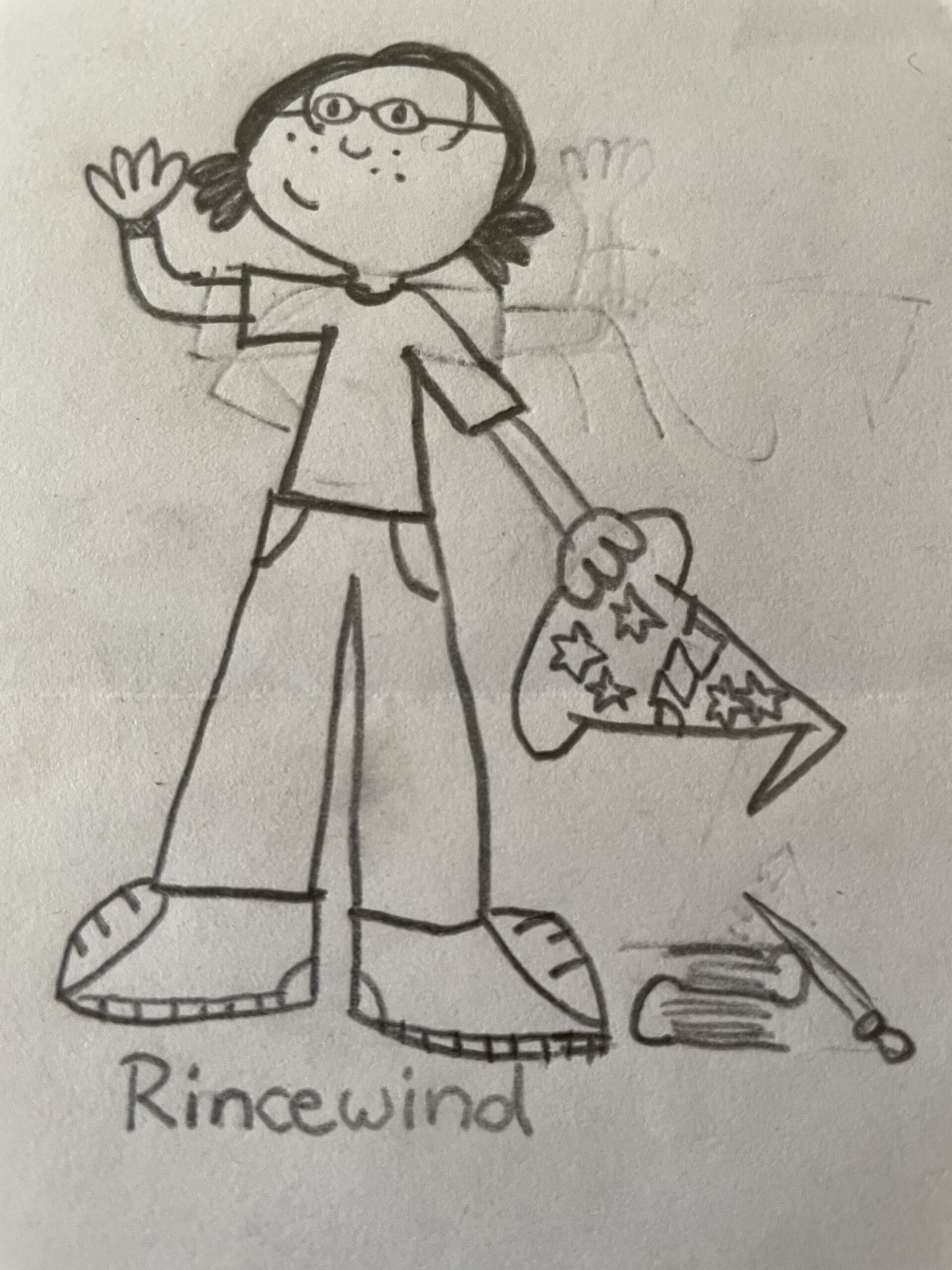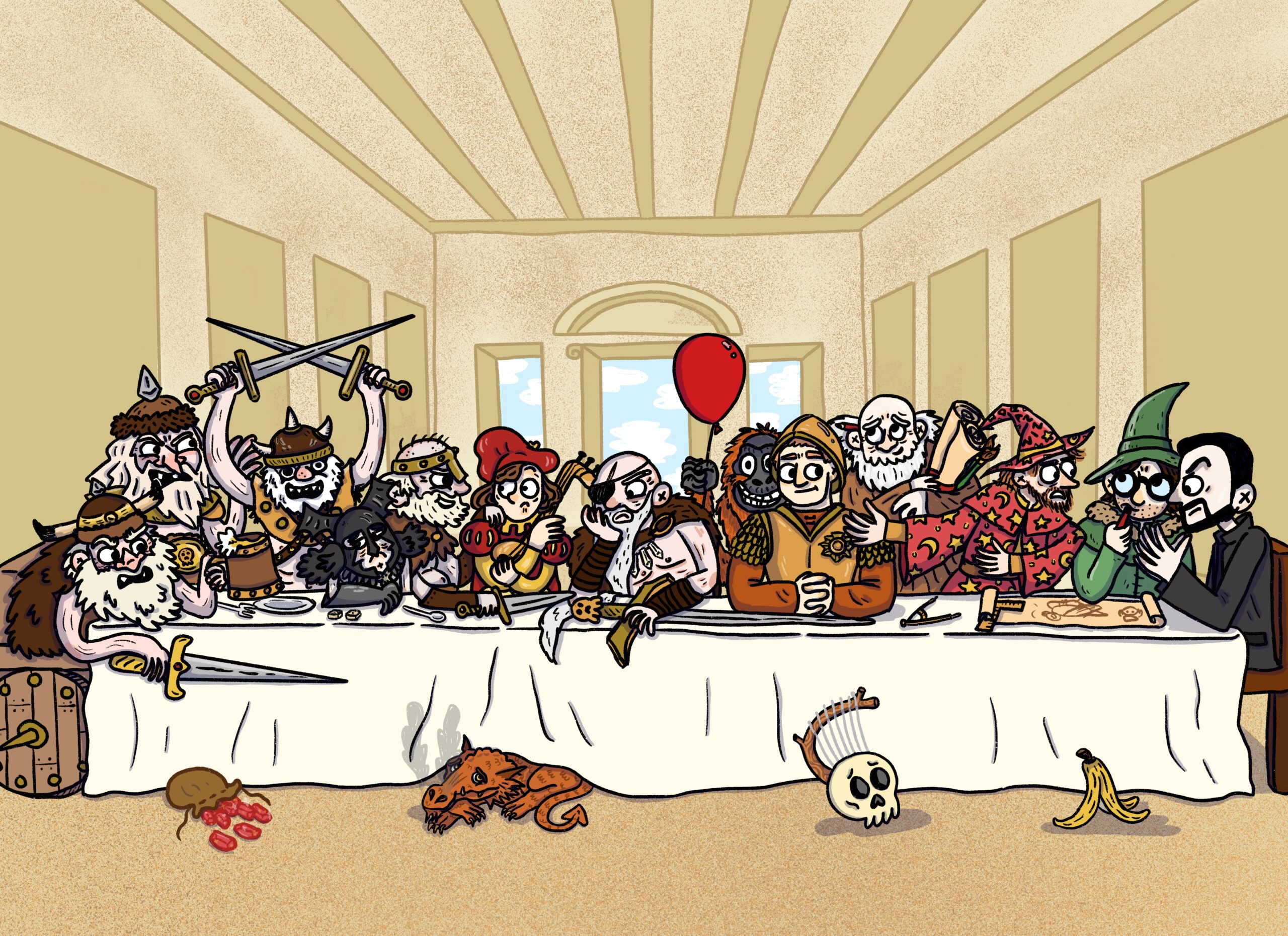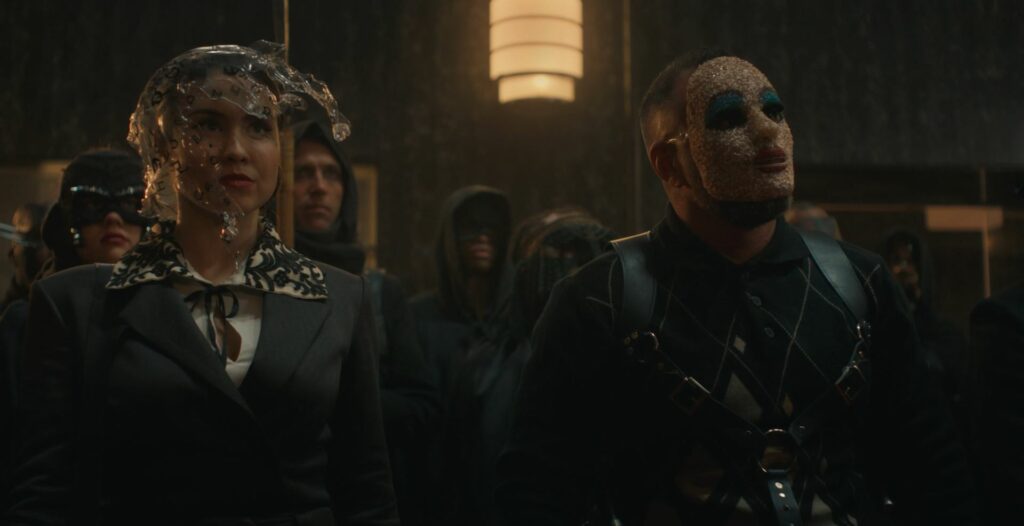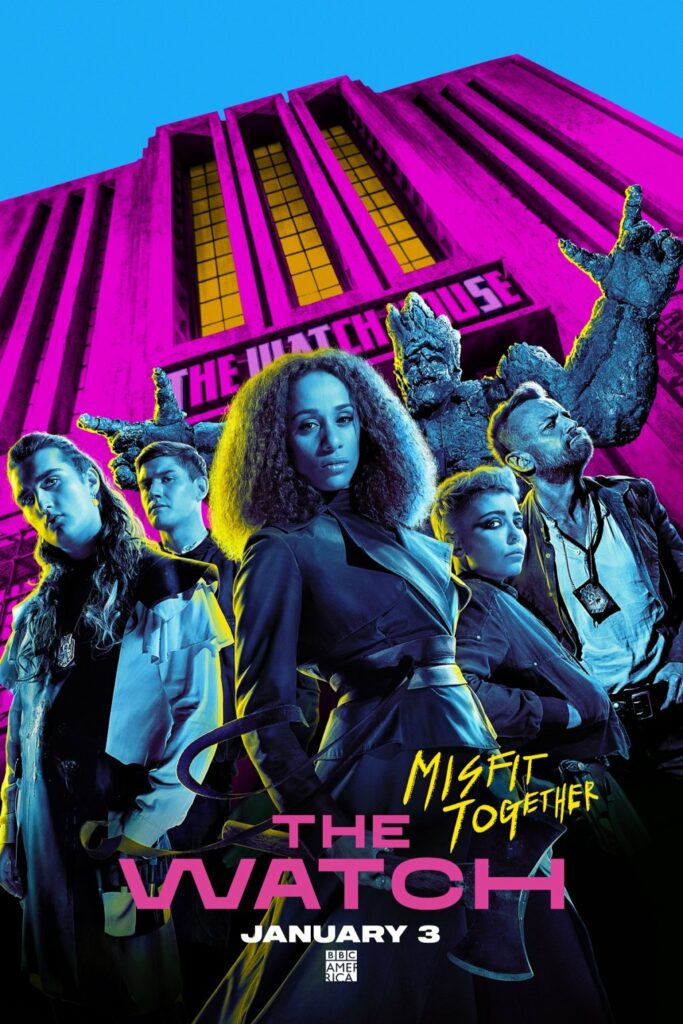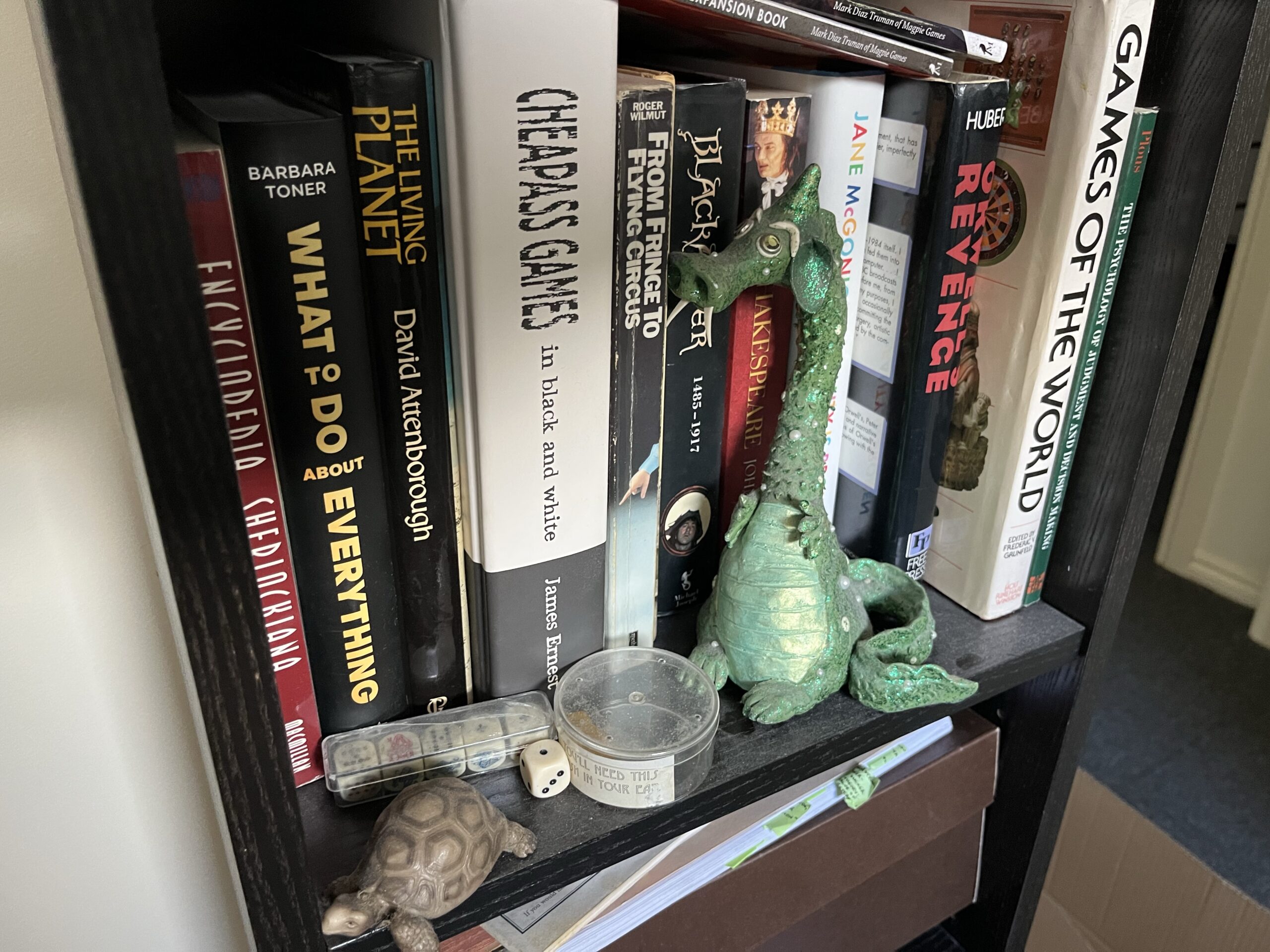#Pratchat58 Notes and Errata
These are the episode notes and errata for Pratchat episode 58, “The Barbarian Switch“, discussing the 1988 short story “Final Reward“.
Iconographic Evidence
We’ve so far been unable to find the Edwardian cartoon of the shocked boy reading the final Sherlock Holmes story, but we’ll add it here if we can!
In the meantime though, here’s the Czech short film of “Final Reward” – 2013’s Poslední odměna (The Final Reward), adapted by writer and director Lasidlav Plecitý, and starring Jarek Hyebrant as Kevin Dogger (aka Kevina Jareše), Lenka Zahradnická as Nicky (aka Nikola), Tomáš Matonoha as Dogger’s agent, and Marko Igonda as Erdan the Barbarian (aka Barbara Erdana). It’s in Czech, but there are English subtitles. It’s more of a student film – made with the resources of a film school and many supporters – than a fan film.
Notes and Errata
- The episode title was inspired by Netflix’s 2018 Christmas movie The Princess Switch, a romantic comedy remix of The Prince and the Pauper which stars former pop star Vanessa Hudgens. If you like The Christmas Prince and films of that ilk, you’ll love this one. It was popular enough to spawn two sequels, though the first one is (in Ben’s opinion) the best.
- The Edwardian era from which Penny’s favourite comfort fiction comes is quite short: it includes the years between 1901 and 1914, beginning with the reign of King Edward VII and concluding with the outbreak of World War I. The books Penny mentioned are:
- Pollyanna was written in 1912 by American author Eleanor Porter. The titular orphan girl is sent to live with her wealthy but stern Aunt in Vermont. Throughout her misadventures she maintains “The Glad Game” – a persistent optimism she learned from her father as a coping mechanism. (It’s a bit mean we know use “Pollyanna” to mean “overly or annoyingly positive”.) It was the first of twelve “Glad Books” about the character, though Porter herself only wrote the first two. Pollyanna was hugely successful at the time, ranking in the top ten best-selling books in the US for three years between 1913 and 1915, peaking at number two in 1914.
- Rebecca of Sunnybrook Farm was written in 1903 by American author Kate Douglas Wiggin. Rebecca is not an orphan, but is sent to live with two of her mother’s sisters in Riverboro, Maine to improve her prospects, as her family is large and poor. She also exhibits a joy for life that inspires her Aunts.
- We’ve yet to identify the one with the violin-playing child who redeems a crusty old farmer; let us know if you recognise this one!
- Little Lord Fauntleroy was written by English-American author Frances Hodgson Burnett, originally in serialised form from 1885 to 1886. That makes it Victorian rather than Edwardian, but it fits in here. Cedric Errol lives in “genteel poverty” in New York with his mother after the death of his English father; his grandfather, a wealthy Earl who was disappointed that his son married an American, offers them a house if they will come to England so Cedric can be raised and educated as an English aristocrat, but of course in the end it’s the Earl who is educated by the boy.
- The Secret Garden was also written by Frances Hodgson Burnett, serialised from 1910 to 1911. The protagonist Mary Lennox has a pretty miserable start: her British parents live in India and do not want or care for her, and being doted on by their servants leaves her spoilt and ill-tempered. When her parents die in a cholera epidemic she is eventually sent to live with her uncle Archibald Craven, described as a “hunchback”, who lives in a country house on the Yorkshire Moors.
- By Gutenberg Press, Penny is referring to Project Gutenberg – the oldest digital library in the world. It was founded in 1971 by American writer Michael Hart, and is run by volunteers. It works to create and freely offer electronic versions of books which are out of copyright – including all of the above books!
- Of note is a recent Twitter thread discussing Pratchett’s allusions to classic children’s fiction:
- We’ve previously discussed Tom Brown’s School Days in our episode about Pyramids (#Pratchat5, “Ten Points to Viper House“).
- George MacDonald Fraser (1925-2008) was a British author best known for The Flashman Papers, a series of eleven novels and one story story collection in which Harry Flashman, a bully from Tom Brown’s School Days who was expelled from Rugby School for being drunk, joins the army. It’s probably a bit of a stretch to call Flashman even an anti-hero, as he rarely does the right thing – he’s a drunkard, a rake and a cad. Usually through cowardice, Flashman survives and indeed influences (often badly) many historical battles, and pursues (with varying levels of success) many famous women from history. While he lives into the twentieth century – he is said to have died in 1915, making him around a century old, as Tom Brown’s School Days is set in the 1830s – the books only detail his military career between 1839 to 1894. The final book, Flashman and the Tiger, was published in 2005, but note that the books were not written or published in chronological order.
- Cobra Kai is a 2018 streaming series, originally produced for YouTube but now owned by Netflix. It’s a sequel to the original Karate Kid films. In the 1984 original, new kid in town Danny LaRusso trains with his Japanese neighbour, Mr Miyagi, so he can defend himself from the local bullies of the Cobra Kai dojo – including Johnny Lawrence, who he defeats at a tournament at the end of the first film. The new series looks at the events of that time from Johnny’s perspective, but takes place in the present, when Johnny re-opens the Cobra Kai dojo – and his rivalry with Danny. Many other characters from the original films have appeared, most played by their original actors. The show has run for four seasons so far, with a fifth due for release in October 2022.
- G.M. – The Independent Fantasy Roleplaying Magazine was published monthly by Croftward Publishing in the UK between September 1988 and March 1989. It lasted 19 issues in competition with the official Dungeons & Dragons magazines, Dragon and Dungeon, and White Dwarf magazine from Games Workshop, the company behind the popular Warhammer tabletop wargames. “Final Reward” appeared in the magazine’s second issue. Issue eleven features the short story “The Exam” – Pteppic’s Assassin’s Guild exam from Pyramids (see #Pratchat5, “Ten Points to Viper House”), with the flashbacks to his life in the Guild edited out, plus the “Adventuring in Discworld” article, the bulk of which is an adventure for Advanced Dungeons & Dragons, and Pratchett’s response to it. The adventure has some lovely touches, including a suspiciously familiar plot setup involving a tourist to Ankh-Morpork named “ThreeTree”, the first ever published map of Ankh-Morpork (as far as we can tell), and a section on additions to the AD&D rules which includes the non-weapon proficiencies “Alcohol Lore”, “Mix Cocktails”, “Smell Coins”, “Speak Utter Rubbish”, “Detect Utter Rubbish” and “Dramatic Entrance”. Also of note: this article describes the Discworld books as “classics” in 1988 – contemporary evidence that they really made a splash early, at least in nerd circles! You can find the entire issue 11 of GM in the Internet Archive here.
- As it turns out, the G.M. article mentioned above was not the first Discworld article in a roleplaying magazine. There were at least two earlier ones:
- The first seems to have been issue 82 of White Dwarf magazine, from October 1986, which included an extract from The Light Fantastic – only a few months after the book was first published. The three pages include the sequence of Galder Weatherwax summoning Death, and Rincewind and Twoflower’s encounter with the gnome in the forest of Skund. It’s followed by a competition in which readers could win signed copies of the first two Discworld novels, plus a copy of the very first Discworld computer game – The Colour of Magic “graphic adventure” (the term used optimistically for text adventures with accompanying pictures at the time, rather than the later era of graphic adventures in the 1990s), published by Pirahna in 1986. The issue also includes “A Stroll Across the Discworld”, written by Ashley Shepherd, which adapts details from the first two novels for play using Advanced Dungeons & Dragons. It includes notes on characters, magic, and creatures, plus a few plot ideas, over five pages, though the first one of those is a full-page reproduction of Josh Kirby’s cover of The Light Fantastic with the title of the article and some very hard to read red text over the top explaining the basic premise of the world.
- Terry was also interviewed in the eleventh and final issue of Adventurer, “The Superior Fantasy & Science Fiction Games Magazine”, published in July 1987. It featured Josh Kirby’s artwork for Equal Rites on the cover, and a four-page interview with Terry in which he discusses his first three novels, as well as the one he’d just sent to the publishers (Mort) and the one he was currently writing (Sourcery). There’s no Discworld adventure, but Terry does also talk about his own experiences with Dungeons & Dragons, including the fun he had as a DM and laying claim to being “the first person to put a lavatory in a dungeon”. Adventurer #11 also on the Internet Archive, along with the ten previous issues. It sounds very much like a “Discworld roleplaying” episode lies in our future, doesn’t it?
- Letters and Numbers is the Australian version of the very nerdy gameshow Countdown, itself the UK’s version of the original French gameshow Des chiffres et des lettres (“Numbers and Letters”), from which the Australian version gets its name. The show alternates between letters rounds, in which contestants request a mix of randomly drawn consonants and vowels and must make the longest word possible, and numbers rounds, in which contestants request a mix of random “large” and “small” numbers, which they must use in a series of equations to achieve a randomly assigned target result. Letters rounds were overseen by crossword compiler and previous Pratchat guest David Astle (#Pratchat6), and numbers rounds by mathematician Lily Serna. The Australian version, produced by SBS, ran from 2010 to 2012, and Ben was a contestant on one episode! (He didn’t win, but made a reasonable showing against the multiple-episode champion.) The original Letters and Numbers was hosted by former Australian newsreader Richard Morecroft. In 2021 SBS brought the show back as Celebrity Letters and Numbers, hosted by Michael Hing but with Astle and Serna in their prior roles. The celebrity version retains the original format, if with more time for banter between (and during) rounds. In the UK, there’s the similar Nine Out of Ten Cats Does Countdown, which takes the host and comedian guests from the panel show Nine Out of Ten Cats and has them play Countdown (though only very, very loosely).
- Dungarees is a slang term in British English for “bib-and-brace” style overalls. The name comes from “dungaree”, the name of a tough calico-like cotton cloth similar to denim, and which was used to make overalls sold in the UK. Since dungarees were originally sold as safety gear for manual labourers, the “women in dungarees” stereotype is one of many that seeks to ridicule women who fulfil traditionally masculine roles.
- Zen Buddhism is a meditative form of Buddhism that originated in China and later spread to Korea, Vietnam and Japan. Zen (禅) is the Japanese name; it comes from the original Chinese name, Chánzōng (禪宗), where chán is a short form of chánnà (禪那), itself a translation of the Sanskrit word for meditation, dhyāna (ध्यान). While sitting meditation is a common and importance practise in Zen Buddhism, receiving money for doing so isn’t really a thing. Yen, meanwhile, is the English name for the Japanese currency en (圓 or えん), represented by the symbol ¥. The “Y” comes from historical pronunciations in Japan which used a J sound, which was written down and interpreted by Portuguese missionaries as a “Y”, something which affected the way many Japanese words were written in English too.
- Kring the talking sword appears in books two and three of The Colour of Magic, as discussed in #Pratchat14, “City-State Lampoon’s Disc-wide Vacation”. Penny compares him to the magical sword possessed by Michael Moorcock’s anti-hero Elric of Melniboné, Stormbringer (not Stormbreaker as we mistakenly refer to it). Stormbringer gives the usually physically weak Elric great strength, but only by feeding on the souls of intelligent creatures.
- “I am Groot” is the only phrase spoken by the character Groot, an alien who is essentially a humanoid, animate tree, in the Marvel Guardians of the Galaxy comics and their film adaptations. Like most Pokémon who can only say their own names, Groot still manages to convey a variety of meanings. It’s even implied in the films that he’s speaking a complex language which his companions, Rocket Raccoon and later Thor, are able to understand – a bit like Chewbacca’s growls in the Star Wars films.
- Cosplay – a portmanteau of “costume play” – is a Japanese term which dates back to 1984; the Japanese word is kosupure (コスプレ). This means it was around when Pratchett wrote “Final Reward”, but it didn’t become a common term – certainly not outside of Japan – until the 1990s, so he probably hadn’t heard it then. It can be traced back to an article written by Nobuyuki Takahashi, a Japanese television director, after his experience seeing the “Masquerade” at the 1984 World Science Fiction Convention (Worldcon for short) in L.A. “Masquerade” has connotations of “aristocratic” costumes in Japanese, so he coined a new compound word in the tradition of many Japanese terms. Such costume events had been a mainstay of science fiction and fantasy conventions since the 1960s, and indeed Pratchett had seen some himself in his early attendance of UK cons, including EasterCon.
- The Northern Line is a route on the London Underground, coded black on standard underground maps. It runs from Morden in the south all the way to High Barnet in the north, and uniquely has two separate alternate routes. This makes it tricky to place Dogger’s residence, though as its one of the most underground lines (there are a lot of above-ground stations in the underground), and Dogger’s part of the line seems to be surface level, it’s likely he’s somewhere in north London, perhaps in the vicinity of Finchley. Fun stations on the Northern line include Tooting Bec, three of the English Monopoly board stations, and most importantly…Mornington Crescent! (That’s a slightly obscure now British radio comedy reference, so don’t worry if you didn’t get it.)
- By 1988, Pratchett had in fact quit his day job to write full-time, and signed his first big publishing contract for a lot of money. Terry had given notice to his manager at the Central Electricity Generating Board in July 1987, in between the publication of Equal Rites and that of Mort, and told Colin Smythe, now his agent rather than his publisher. Smythe solicited a deal for Terry’s next six books, and after some competition between Gollancz and Transworld, Pratchett signed with the former in December 1987 for an advance of £51,000 per book – a total of £306,000 (around £740,000, or more than one and a quarter million Australian dollars, in today’s money). He was definitely doing very well, so it’s little wonder he could write about Dogger doing the same.
- The TARDIS – the Doctor’s time and space travelling home in Doctor Who – is meant to blend in with its surroundings by changing shape using its “chameleon circuit”, but since the programme’s invention that circuit has malfunctioned and its been stuck as various designs of 1960s London Police Box. While this sometimes did cause some it to be noticed in the original series, as Liz remarks it’s still invisible to “most people” thanks to the concept of the “perception filter” – a presumably slightly psychic effect that causes those who notice it to treat it as commonplace, in a manner similar to Douglas Adams’ idea of the “Somebody Else’s Problem” field.
- Neighbours was Australia’s longest-running and most internationally successful soap opera. Since 1985 it ran daily during the week for just over 8,900 episodes, initially produced for Channel Seven, but then moving over to Ten. It became hugely popular in the UK, where it aired on BBC One for 21 years until 2008, when it was picked up by Channel 5. In 2022 Channel 5 announced they would not be continuing to carry the show, cutting off its main source of funding, and Fremantle Productions were unable to find another broadcaster to pick up the deal. It thus ceased production and went out with a big double-episode finale on 28 July, 2022, featuring the return of many beloved characters from its long history – including big name actors and pop stars who got an early break on the show, like Kylie Minogue, Guy Pearce and Margot Robbie. It’s left a huge gap in the Australian television landscape, as it provided jobs and professional experiences for thousands of production crew, directors, writers and actors.
- Houris are mentioned just four times in the Quran, and are (at least in the majority opinion) not mortal women but supernatural creatures of Hannah, the Islamic Paradise. Houris are described as “companions” whose main features are that they have “wide and beautiful eyes” and are “untouched” (which probably means what you’re inferring, yes). The Quran does not promise any specific number of them to anyone, though hadiths – other accounts of the words and deeds of the prophet Mohammed, seen as more or less canonical depending on an individual’s beliefs – describe them in many ways, lots of them pretty weird.
- On the subject of characters having a life of their own, the closest thing we could find Pratchett saying is that he often doesn’t know what he’s doing when starting to write a book – writing it is the way he finds out, and “often, one of the characters says something that tells me what the story is about.” This is from the acceptance speech he wrote (but did not personally give) for the Boston Globe-Horn Book Award, which he won for Nation in 2009. The speech is collected in A Slip of the Keyboard.
- The Hero’s Journey (aka the “monomyth”) is Joseph Campbell’s famous condensation of the Western canon into a single structure, presented in his 1949 book The Hero With a Thousand Faces. While its not nearly as universal as Campbell presumed, it has become canonised and used repeatedly in the construction of modern fiction, most famously when George Lucas explicitly used it as a model for Star Wars. “The Refusal of the Call” is an early stage of the Journey, in which the hero initially refuses to leave their home behind and go on the quest to which they are being called. This is still really common in fantasy fiction, especially urban fantasy, where protagonists often deny that the fantastic world they’re being shown is even real.
- “In the beginning was the Word” is that first line of the first chapter of the Book of John, one of the four canonical gospels in the New Testament of the Bible. It goes on to say “and the Word was with God, and the Word was God”, which has been a subject of debate among theologians for centuries. In this context, “the Word” is an English translation of the Greek logos (λόγος), which is usually interpreted to mean Jesus, and so the full verse is the genesis of many Christian beliefs, including the Trinity – that Jesus is God but also separate from God.
- 100 Story Building is the creative writing centre for children and young people where Ben has worked for the last seven years or so. In their workshops they try to deal with a number of barriers young people face when writing, including the intimidating feeling of staring at a blank page waiting to be filled.
- The quote “There is nothing to writing. All you do is sit down at a typewriter and bleed.” is often attributed to Ernest Hemingway, and sometimes to another author, Gene Fowler. As is so often the case with these things, neither of those is likely to be true. Anecdotally at least a version close to the one attributed to Hemingway was attributed to Walter Wellesley “Red” Smith, whose work was known to Hemingway, making it plausible he might have said it. That version was: “You simply sit down at the typewriter, open your veins, and bleed.” But it seems the earliest confirmed version was written by American sportswriter and novelist Paul Gallico (of The Poseidon Adventure fame) in his 1946 book Confessions of a Story Writer, in which he says: “It is only when you open your veins and bleed onto the page a little that you establish contact with your reader.”
- We’ve previously mentioned Terry’s hard drives of unfinished being destroyed by a steamroller in #Pratchat6, #Pratchat16, #Pratchat26, #Pratchat30, and #Pratchat49. This was indeed part of his will, executed by his personal assistant Rob Wilkins in August 2017, as described in this Guardian article.
- Bohemian writer Franz Kafka (1883-1924) did write a letter to his best friend, Max Brod, in which he seemingly requested all his work to be burned. Brod found the letter – described as a “last will” – when going through his desk after Kafka had died of tuberculosis. “Everything I leave behind me…is to be burned unread”, he wrote, though there’s some thought that his applied only to his personal and unpublished writing. Brod did not comply, though its worth noting that Kafka’s most famous story, “The Metamorphosis”, had been published during his life, in 1915. Even that did not find widespread fame, though, until after his death.
- Jules Verne’s posthumously published novel Paris in the Twentieth Century – discovered by his great grandson in a safe in 1989, and published in 1994 – thankfully does not seem to be disputed in its authenticity. Tolkien’s later published works are also seen as legit, including the twelve-volume A History of Middle-Earth, compiled by Christopher Tolkien (J.R.R.’s son, not his grandson as we mistakenly say). These books are a compilation of his notes, drafts and other writings, forming a history of Tolkien’s process of creating the world of Middle-Earth (and not, as the title might suggest, a history of the world itself).
- Shirley Jackson (1916 – 1965) was an American horror and mystery writer, whose best known work includes the novel The Haunting of Hill House and the short story “The Lottery”. We previous discussed her in Penny’s last appearance, #Pratchat45, “Hogswatch in Grune”. The anthology Penny read is Let Me Tell You: New Stories, Essays, and Other Writings, edited by two of Jackson’s four children and published in 2015. It contains more than forty unpublished (and very likely unfinished) pieces of writing.
- “The High Meggas” (discussed in #Pratchat57West5), the short story precursor to Prachett’s Long Earth series, was first published in early editions of The Long Earth in 2012, and then again in the collection A Blink of the Screen later that year. It’s given a date of 1986 in the introduction used in both books, but accounts conflict between Pratchett and his publisher Colin Smythe as to when exactly it was written. See the notes to #Pratchat57West5 for more on this.
- Of the collections of Pratchett’s early short stories, only the first two (2014’s Dragons at Crumbling Castle and 2015’s The Witch’s Vacuum Cleaner) have introductions written by Terry, indicating that he had tweaked the stories within a little. They are, though, “mostly as they were first printed”.
- English horror writer Ramsay Campbell started writing his first book when he was eleven, and it is this unpublished collection of fiction – titled Ghostly Stories – which contained the infamous sentence “The door banged open, and the afore-mentioned skeleton rushed in.” In an interview given in 2008, he cited it as evidence that he wasn’t yet at the height of his powers though he did submit it to publishers and got some encouragement, if not a contract.
- Stephen King’s The Dark Half is a 1989 horror novel about alcoholic author Thad Beaumont, a writer of serious but unpopular “literary fiction” who finds success as “George Stark”, a pen name under which he writes violent crime thrillers about a sadistic serial killer. When Thad is outed as Stark, he and his wife stage a mock burial of the pseudonym…only for him to rise bodily from the grave and go on a killing spree of his own… This does seem to have been prompted by King’s own outing as Richard Bachmann, the name under which King wrote darker, more cynical books. Both pen names were inspired by “Richard Stark”, a pseudonym used by Donald E Westlake.
- Subscriber Ian Banks identified a couple of other Stephen King stories relevant to this episode: “Word Processor Of The Gods”, published in Skeleton Crew, has a main character who is gifted a word processor that can reshape reality, while “Umney’s Last Case” (collected in Nightmares and Dreamscapes) is quite similar to “Final Reward”, but told from the point of view of the fictional character.
- Inkheart (Tintenherz) is a 2003 young adult fantasy novel by German author Cornelia Funke. It tells the story of Meggie, a young woman whose father, Mo, is a bookbinder who she discovers has a special gift: he is able to bring things out of the world of books, the Inkworld, into the real world – but only if something from the real world goes into Inkworld in return… Inkheart is the first in the Inkworld trilogy, followed by Inkwell (2005) and Inkdeath (2008). Funke announced in 2021 she will return to the series with The Colour of Revenge (Die Farbe der Rache), scheduled for publication in 2023. The first book was filmed in 2006 as Inkheart with a great cast including Brendan Fraser (as Mo), Eliza Bennett (as Meggie), Helen Mirren, Jim Broadbent, Paul Bettany and Andy Serkis.
- As Penny alludes, Shirley Jackson’s marriage to college teacher and critic Stanley Edgar Hyman was likely unhappy; her biographers reckon Stanley frequently cheated on her – often with his college students – and eventually made her agree to an open relationship she didn’t really want, and also controlled her finances even though she earned most of the money in the household. Perhaps unsurprisingly he was the first person to publish some of her unfinished work, specifically Come Along with Me. This was an unfinished novel, bulked out with many of her best short stories, published three years after her death in 1968.
- Stranger Things – the hit Netflix show drawing on many of the popular “kids on bikes” style horror fantasy films of the 1980s – released its fourth season in two parts in May and July 2022. A new character introduced is Eddie Munson, an older teenager who has failed to graduate from high school several times and is the head of the school’s Dungeons & Dragons club, “The Hellfire Club”. Despite his involvement with D&D, he exemplifies the “nerd jock” role: he bullies the younger members of the club, is disdainful and disrespectful to those who don’t share the hobby, and controls who can and can’t play with them. He also plays heavy rock music and is a known drug dealer at the school, fulfilling many of the negative stereotypes of Dungeons & Dragons players common at the time of the “Satanic panic”, though he does have a kinder side and genuinely seemed to want to help the character who came to him for help.
- Tripod vs the Dragon is a musical written and performed by Australian musical comedy trio Tripod, with guest star Elana Stone. Originally titled Dungeons & Dragons: The Musical and renamed for legal reasons, the trio make themselves into adventurers and get caught up in a plot involving a tree from the dawn of time and its guardian, a dragon. Its first proper season was in 2010 for the Melbourne International Comedy Festival, alongside two lesser known Dungeons & Dragons-inspired comedy shows, +1 Sword and Dungeon Crawl, starring some weird nerds named Ben and Richard McKenzie… The Tripod vs the Dragon album is available via Bandcamp, and the song Penny mentions is the final track, “Bard”. The show was filmed in 2012, and might still be available on DVD; we’ll find out where from and let you know! But if you can’t find one, there’s a watch party coming up just after this episode is published, on 14 August 2022; see this Tweet for details.
- “The Adventure of the Final Problem” was first published in December 1893, and intended by Arthur Conan-Doyle to kill off Sherlock Holmes and be his final story. In it, Holmes tells Watson he has finally proven that many crimes he has investigated are part of the plans of one man: Professor Moriarty, a mastermind who aids other criminals. He avoids several attempts on his life before finally tracking Moriarty to the Reichenbach Falls, a real waterfall in Switzerland that Doyle had visited earlier that year, inspiring the story. Watson is lured away by a false emergency, and when he returns, Holmes has gone – seemingly to his death over the edge of the falls with Moriarty, leaving behind only a letter to Watson. To say this was unpopular with readers of The Strand magazine is a huge understatement; they cancelled their subscriptions in droves, and made their displeasure known in letters to the magazine and Doyle himself. The pressure eventually led him to write The Hound of the Baskervilles (a serialised novel, set before Holmes’ apparent death) in 1901, and later to write more stories – beginning with “The Adventure of the Empty House” in 1903 – which establishes that Holmes had in fact survived, luckily plausible since in the fiction no-one directly saw Holmes die or discovered his body.
- Call of Duty is a long-running series of military first-person shooter videogames published by Actvision. They initially focussed on World War II, though later branched out to other fields of conflict. The 2008 game Call of Duty: World at War, and begins the “Black Ops” storyline that would continue through Call of Duty: Black Ops and its sequels. It also introduced the alternate “zombies” mode, an alternate history multiplayer mode in which players must kill hordes of Nazi zombies. This storyline would persist through multiple games as well, and introduces the character of Doctor Edward Richtofen, a Nazi scientist who creates many of the monsters battled in Zombies mode.
- Amazingly, frozen mammoth meat was supposedly served at a banquet in 1901 at St. Petersburg, and also in around 1951 at the Explorer’s Club in New York. But in both cases, it seems the story was a lie, even if it is true that the indigenous Evenki people of Siberia did sometimes feed it to their dogs. For more on why it would be a) gross and b) impossible to serve up mammoth steak, see Sarah Zhang’s great article “What Happens to Meat When You Freeze It for 35,000 Years”, written for The Atlantic in December 2019.
- Manfred Albrecht Freiherr von Richthofen (1892 – 1918), aka The Baron von Richtofen or the Red Baron, was a notorious German World War I flying ace who shot down around eighty enemy planes, a huge number for the time. In Germany he was known as Der Rote Kampfflieger, “The Red Fighter Pilot”, and this was the title he used for his 1918 autobiography. The “Red” came from the bright colour of his aircraft; his squadron were known as the “Flying Circus”, both for their bright colour, and the fact that they moved around to different stages of the war using tents wherever they set up an airfield. (And yes, this was the inspiration for the title of the Monty Python television series.) He’s been played by many actors, notably Adrian Edmondson in an episode of Blackadder Goes Forth, where he is shot by rival fighter pilot, Rik Mayall’s Lord Flashheart.
- We’d have to make a whole podcast to get through all the Sherlock Holmes stuff we mention this episode (not that Ben, as a Holmes fan, would mind that…), so we’ll instead just list our references here:
- August Derleth’s Solar Ponds appeared in thirteen books’ worth of short stories between 1928 and 1971, and then some more written by Basil Copper.
- Arsene Lupin was created by French author Maurice Leblanc, and is one of several “gentleman thief” type characters created in part as an answer to Holmes. He first crossed paths with Holmes in 1905 in “Sherlock Holmes arrive trop tard” (“Sherlock Holmes Arrives Too Late”), and he was indeed renamed “Herlock Sholmes” (or “Holmlock Shears”), and Watson “Wilson”, at the time (though modern reprints often revert their names, since copyright concerns are no longer as pressing). We note that in the medical mystery television series House, often also said to be inspired by Sherlock Holmes, Dr. House (who displays many Holmesian characteristics) also has a sidekick named Wilson.
- Holmes doesn’t appear in Phoenix Wright Ace Attorney, but in its historical spin-off series, The Great Ace Attorney, set in the Meiji Restoration period of Japan, which coincides with the Victorian era of Holmes. In the original Japanese, Sherlock Holmes appears alongside ten-year-old Iris Watson, Watson’s daughter, after John is murdered. They are renamed Herlock Sholmes and Iris Wilson in international translations.
- In 2020 the Conan-Doyle estate sued several authors for copyright infringement, including Nancy Springer for her books starring Holmes’ young sister, Enola Holmes. The estate claimed that the final ten stories (set after The Final Problem) were not yet in the public domain, and specifically citing the more emotional nature of Holmes in those stories as a comparison point. The suit was dismissed; of note, Holmes already passed into the public domain in the UK in 2000, seventy years after Conan-Doyle’s death, but copyright law varies in different places. In the US, where the Holmes stories were published at the same time as in The Strand, all of the original Holmes stories (and thus the characters themselves) will be out of copyright by 2023.
- Mr Holmes is a 2015 film adaptation of the 2005 novel A Slight Trick of the Mind by American author Mitch Cullin. It’s set in 1947, with a retired 93-year-old Holmes – played by Ian McKellen – trying to remember the details of the last case he took on before retiring 35 years earlier.
- The chimera is a creature from Greek mythology, a fire-breathing hybrid monster most often depicted as a lion with a goat’s head growing from its back and a serpent’s tail (sometimes with a snake’s head at the end). It appears in The Iliad, among other accounts. Most famously, when the hero Bellerophon rejects the advances of King Proetus’s wife, Proetus (who is told Bellerophon approached the Queen) seeks revenge by sending Bellerophon to slay the Chimera, in the hopes he will die in the attempt. Advised by a seer, he captures Pegasus the winged horse and attacks the monster from above, using trickery to kill it. The word chimera is from the Greek Χίμαιρα, Chímaira, meaning “she-goat”. In English the word is now also used to mean any creature (or sometimes any thing) made up of different parts.
- Upstart Crow is Ben Elton’s TV sitcom starring David Mitchell as William Shakespeare, which has run for three series since 2016. A stage play was also performed in 2019.
- Ben touches on the idea of heteropessimism, the acceptance that heteronormative relationships must be awful by heterosexual couples. It’s explored in this article in The Conversation from July 2022.
- Eleanor Morton is a Scottish stand-up and sketch comedian, and one of the funniest people on the Internet. You can see her videos on Twitter, TikTok and Instagram, and also on YouTube. Here’s the recent one Ben mentioned about JRR Tolkien and CS Lewis trying to outdo each other with stupid character names; she also has a series of videos in which historical figures read hatemail sent to them; this video of Arthur Conan-Doyle reading reactions to the death of Sherlock Holmes is especially appropriate to the discussion in this episode. If you’re in the UK, get to the Edinburgh Fringe where you can catch her show Eleanor Morton Has Peaked until 28 August 2022. Alternatively if you enjoy her videos, throw her a few bucks on Ko-Fi. You can hear her talk about her comedy career, as well as Carpe Jugulum, in the second episode of season six of Desert Island Discworld.
More notes coming soon!
Thanks for reading our notes! If we missed anything, or you have questions, please let us know.

